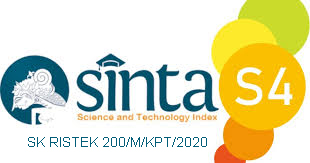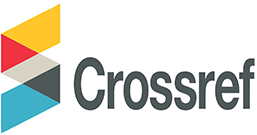Combining Super Resolution Algorithm (Gaussian Denoising and Kernel Blurring) and Compare with Camera Super Resolution
Abstract
This problem addresses the problem of low-resolution image (noisy) that will proof later by PSNR number. The best way to improve this low-resolution problem is by utilizing Super Resolution (SR) algorithm methodology. SR algorithm methodology refers to the process of obtaining higher-resolution images from several lower-resolution ones, that is resolution enhancement. The quality improvement is caused by fractional-pixel displacements between images. SR allows overcoming the limitations of the imaging system (resolving limit of the sensors) without the need for additional hardware. This research aims to find the best SR algorithm in form of stand-alone algorithm or combine algorithm by comparing with the latest SR algorithm (Camera SR) from the previous research made by Chang Chen et al in 2019. Furthermore, we confidence this research will become the future guideline for anyone who want to improve the limitation of their low-resolution camera or vision sensor by implementing those SR algorithms.
Keywords
Full Text:
PDFReferences
K. Zhang, W. Zuo, and L. Zhang, “Learning a Single Convolutional Super-Resolution Network for Multiple Degradations,” 2018, doi: 10.1109/CVPR.2018.00344.
M. Haris, G. Shakhnarovich, and N. Ukita, “Deep Back-Projection Networks for Super-Resolution,” 2018, doi: 10.1109/CVPR.2018.00179.
J. Kim, J. K. Lee, and K. M. Lee, “Accurate image super-resolution using very deep convolutional networks,” in Proceedings of the IEEE Computer Society Conference on Computer Vision and Pattern Recognition, 2016, vol. 2016-December, doi: 10.1109/CVPR.2016.182.
W. S. Lai, J. Bin Huang, N. Ahuja, and M. H. Yang, “Deep laplacian pyramid networks for fast and accurate super-resolution,” in Proceedings - 30th IEEE Conference on Computer Vision and Pattern Recognition, CVPR 2017, 2017, vol. 2017-January, doi: 10.1109/CVPR.2017.618.
B. Lim, S. Son, H. Kim, S. Nah, and K. M. Lee, “Enhanced Deep Residual Networks for Single Image Super-Resolution,” in IEEE Computer Society Conference on Computer Vision and Pattern Recognition Workshops, 2017, vol. 2017-July, doi: 10.1109/CVPRW.2017.151.
A. Shocher, N. Cohen, and M. Irani, “Zero-Shot Super-Resolution Using Deep Internal Learning,” 2018, doi: 10.1109/CVPR.2018.00329.
Y. Tai, J. Yang, and X. Liu, “Image super-resolution via deep recursive residual network,” in Proceedings - 30th IEEE Conference on Computer Vision and Pattern Recognition, CVPR 2017, 2017, vol. 2017-January, doi: 10.1109/CVPR.2017.298.
T. Tong, G. Li, X. Liu, and Q. Gao, “Image Super-Resolution Using Dense Skip Connections,” in Proceedings of the IEEE International Conference on Computer Vision, 2017, vol. 2017-October, doi: 10.1109/ICCV.2017.514.
Z. Xiong, X. Sun, and F. Wu, “Robust web image/video super-resolution,” IEEE Trans. Image Process., vol. 19, no. 8, 2010, doi: 10.1109/TIP.2010.2045707.
Y. Zhang, K. Li, K. Li, L. Wang, B. Zhong, and Y. Fu, “Image super-resolution using very deep residual channel attention networks,” in Lecture Notes in Computer Science (including subseries Lecture Notes in Artificial Intelligence and Lecture Notes in Bioinformatics), 2018, vol. 11211 LNCS, doi: 10.1007/978-3-030-01234-2_18.
Y. Zhang, Y. Tian, Y. Kong, B. Zhong, and Y. Fu, “Residual Dense Network for Image Super-Resolution,” 2018, doi: 10.1109/CVPR.2018.00262.
A. Bulat and G. Tzimiropoulos, “Super-FAN: Integrated Facial Landmark Localization and Super-Resolution of Real-World Low Resolution Faces in Arbitrary Poses with GANs,” 2018, doi: 10.1109/CVPR.2018.00019.
Y. Blau, R. Mechrez, R. Timofte, T. Michaeli, and L. Zelnik-Manor, “The 2018 PIRM challenge on perceptual image super-resolution,” in Lecture Notes in Computer Science (including subseries Lecture Notes in Artificial Intelligence and Lecture Notes in Bioinformatics), 2019, vol. 11133 LNCS, doi: 10.1007/978-3-030-11021-5_21.
X. Deng, “Enhancing Image Quality via Style Transfer for Single Image Super-Resolution,” IEEE Signal Process. Lett., vol. 25, no. 4, 2018, doi: 10.1109/LSP.2018.2805809.
J. Johnson, A. Alahi, and L. Fei-Fei, “Perceptual losses for real-time style transfer and super-resolution,” in Lecture Notes in Computer Science (including subseries Lecture Notes in Artificial Intelligence and Lecture Notes in Bioinformatics), 2016, vol. 9906 LNCS, doi: 10.1007/978-3-319-46475-6_43.
C. Ledig et al., “Photo-realistic single image super-resolution using a generative adversarial network,” in Proceedings - 30th IEEE Conference on Computer Vision and Pattern Recognition, CVPR 2017, 2017, vol. 2017-January, doi: 10.1109/CVPR.2017.19.
M. S. M. Sajjadi, B. Scholkopf, and M. Hirsch, “EnhanceNet: Single Image Super-Resolution Through Automated Texture Synthesis,” in Proceedings of the IEEE International Conference on Computer Vision, 2017, vol. 2017-October, doi: 10.1109/ICCV.2017.481.
X. Wang, K. Yu, C. Dong, and C. Change Loy, “Recovering Realistic Texture in Image Super-Resolution by Deep Spatial Feature Transform,” 2018, doi: 10.1109/CVPR.2018.00070.
T. Michaeli and M. Irani, “Nonparametric blind super-resolution,” 2013, doi: 10.1109/ICCV.2013.121.
R. Timofte, S. Gu, L. Van Gool, L. Zhang, and M. H. Yang, “NTIRE 2018 challenge on single image super-resolution: Methods and results,” in IEEE Computer Society Conference on Computer Vision and Pattern Recognition Workshops, 2018, vol. 2018-June, doi: 10.1109/CVPRW.2018.00130.
A. Bulat, J. Yang, and G. Tzimiropoulos, “To learn image super-resolution, use a GAN to learn how to do image degradation first,” in Lecture Notes in Computer Science (including subseries Lecture Notes in Artificial Intelligence and Lecture Notes in Bioinformatics), 2018, vol. 11210 LNCS, doi: 10.1007/978-3-030-01231-1_12.
DOI: https://doi.org/10.31326/jisa.v4i2.914
Refbacks
- There are currently no refbacks.
Copyright (c) 2021 Muhamad Ghofur, Tjong Wan Sen

This work is licensed under a Creative Commons Attribution-ShareAlike 4.0 International License.
JOURNAL IDENTITY
Journal Name: JISA (Jurnal Informatika dan Sains)
e-ISSN: 2614-8404, p-ISSN: 2776-3234
Publisher: Program Studi Teknik Informatika Universitas Trilogi
Publication Schedule: June and December
Language: Indonesia & English
APC: The Journal Charges Fees for Publishing
Indexing: EBSCO , DOAJ, Google Scholar, Arsip Relawan Jurnal Indonesia, Directory of Research Journals Indexing, Index Copernicus International, PKP Index, Science and Technology Index (SINTA, S4) , Garuda Index
OAI address: http://trilogi.ac.id/journal/ks/index.php/JISA/oai
Contact: jisa@trilogi.ac.id
Sponsored by: DOI – Digital Object Identifier Crossref, Universitas Trilogi
In Collaboration With: Indonesian Artificial Intelligent Ecosystem(IAIE), Relawan Jurnal Indonesia, Jurnal Teknologi dan Sistem Komputer (JTSiskom)
JISA (Jurnal Informatika dan Sains) is Published by Program Studi Teknik Informatika, Universitas Trilogi under Creative Commons Attribution-ShareAlike 4.0 International License.


















